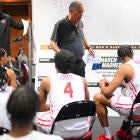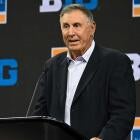
As the dollar values increase with new media rights deals, those in favor of a pay-for-play model in big-time college athletics get louder. As the critics of modern day "amateurism" get louder, those in defense of the system, like Oklahoma coach Bob Stoops, have begun to speak out in favor of the current model.
"I don't get why people say these guys don't get paid," Stoops told Sporting News' Matt Hayes. "It's simple. They are paid quite often, quite a bit and quite handsomely."
What Stoops is referring to is the cost of tuition, room and board, along with other expenses covered by the university for most scholarship players. At Oklahoma, those costs for an out-of-state student add up to $29,924.50 per year.
"Ask the kids who have to pay it back over 10-15 years with student loans," Stoops said. "You get room and board, and we'll give you the best nutritionist, the best strength coach to develop you, the best tutors to help you academically, and coaches to teach you and help you develop. How much do you think it would cost to hire a personal trainer and tutor for four, five years?"
Stoops does have a point in that these players are receiving better treatment than most students at the university. However, most students are not directly responsible for generating millions of dollars in revenue. In his discussion with Sporting News, the Oklahoma coach suggested the demand for Sooners football would be the same regardless of the player.
"Sam Bradford was one of the most humble and grounded players I’ve ever been around; he got it," Stoops said. "But I even told him, what makes you think those fans in the stands are wearing No. 14 for you? Who says it’s not an old Josh Heupel jersey? I tell our guys all the time. It could be you—or it could be anyone else.
"Those 70,000 fans in the stadium are cheering and buying tickets to see Oklahoma."
Other coaches, such as Nick Saban, have acknowledged the changing financial landscape in college football. In January, the Alabama coach suggested players should have the opportunity to benefit from the rising demand in the sport.
"I think especially where we've sort of gotten to from a business perspective relative to the financial end of things that there isn't really any good reason that the student-athletes who create that should not share in that to some degree," Saban said in January before winning his third BCS title in four years.
Stoops has an answer for most of the critical questions in the pay-for-play discussion. He earns more than $4 million a year coaching the Sooners, but Stoops credits his former mentors at Iowa for his current success. That experience and the opportunities that follow, Stoops argues, are available to all student-athletes.
The debate of pay-for-play, what defines the "full cost" of a scholarship and other issues will continue throughout the offseason. Safe to say we will be hearing from more coaches and administrators in the coming months.
![[object Object] Logo](https://sportshub.cbsistatic.com/i/2020/04/22/e9ceb731-8b3f-4c60-98fe-090ab66a2997/screen-shot-2020-04-22-at-11-04-56-am.png)

















